|
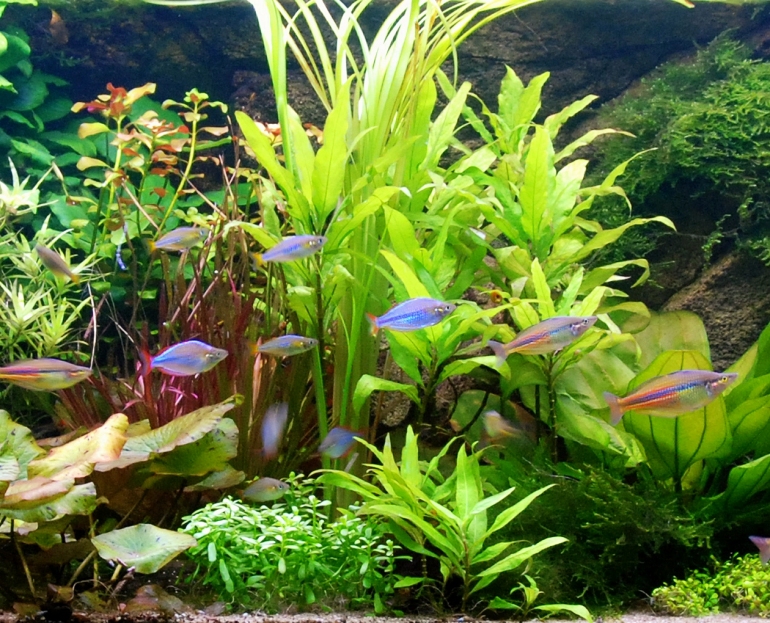 |
photo© Hans Booij |
Melanotaeniidae and Pseudomugilidae are two closely related families of freshwater fishes restricted in distribution to Australia and New Guinea. They are commonly known as rainbowfishes and blue eyes respectively. Ten genera are currently recognised: Cairnsichthys, Chilatherina, Glossolepis, Iriatherina, Kiunga, Melanotaenia, Pelangia, Pseudomugil, Rhadinocentrus, and Scaturiginichthys. Melanotaenia is by far the largest genus. The Pseudomugilidae family has been well studied in recent years but controversy still exists as to whether they should be regarded as a separate family or in a subfamily of Melanotaeniidae. No less controversial in recent years has been the position of their relationship to other atheriniformes, most notably to the Telmatherinidae and Bedotiidae families.
Australia and New Guinea are much more than just adjacent land masses, as they have been connected throughout most of their history. The Sahul Shelf, beneath the shallow Arafura Sea and Torres Strait that now separate the two countries, was above sea level until as recently as about 6000 years ago during the latest glacial lowering of the sea level, and southern New Guinea streams were confluent with those of the adjacent Australian coast. Indeed, about 50 species of freshwater fishes from southern New Guinea also occur in northern Australia, emphasising the historical link between the regions, and many of these are endemic to both regions. The Olive and Jardine Rivers show some of the strongest relationship, with 81% and 63% of the fish species found in these rivers being common between the two countries.
Australia and New Guinea are perhaps better known for their marine fish fauna rather than for their freshwater fauna. Nevertheless, the freshwater fishes of Australia and New Guinea are distinctive and have been the subject of significant discovery over the last 30 years. The amount of recent ichthyological activity in Australia and New Guinea can be gauged conservatively from the number of recently described species or subspecies. Since 1970 about 70 Australian and about 130 New Guinea freshwater fish species or subspecies were described or are awaiting description. New species have been found and described at rates as high as any in the history of Australian and New Guinea ichthyological exploration. Australian rainbowfishes have been reasonably well studied, in terms of their systematics, but new species continue to be described based mainly on genetic taxonomic research of known species. In contrast to the Australian species, very little is known about the New Guinea rainbowfishes. New Guinea rainbowfishes are so hopelessly under-collected that valid generalisations about their distribution are impossible.
New Guinea has been the focal point for a host of natural history studies involving diverse groups such as reptiles, birds, and mammals. However, relatively few collections of the freshwater fish fauna have been undertaken. Field surveys and published taxonomic works have been sporadic since the first species were discovered in the mid 1800s. Historically there have been considerable problems associated with fieldwork in the interior. Aside from the dangers of malaria and other diseases, potential collectors were discouraged by the hazards of overland travel across very difficult terrain. Consequently, most early collections were obtained near the coast or along navigable rivers. The most active period of ichthyological exploration occurred between 1903 and 1920 by Dutch naturalists. The majority of these early collections were summarised by Weber in 1913.
.Hans.jpg) |
Pseudomugil gertrudae [Aru Islands] photo© Hans Booij |
There has been a pronounced renewal of interest in New Guinea rainbowfishes during the past 30 years, in part due to the development of a modest air transport network, as well as road construction in previously inaccessible districts. Most recent research has involved Papua New Guinea, the island's eastern half. Comprehensive surveys have been conducted for the Fly, Purari, Laloki, Kikori, Sepik, Ramu, and Gogol rivers, as well as many other regions. As a result of these investigations there now exists a reasonably knowledge of the rainbowfishes inhabiting the eastern half of the island. Unfortunately, the western half, the Indonesian province of West Papua, remains poorly studied. Our knowledge of the rainbowfishes of this vast area is still largely based on the now out-dated work of the early Dutch explorers. The Timika region and sections of the Mamberamo basin have been sampled, but most regions remain unsurveyed. However, several scientific expeditions have been undertaken in West Papua since 2007 mainly in the Bird's Head Peninsula region (including the nearby Raja Ampat Islands and Bomberai Peninsula) by the Institut de Recherche pour le Développement, the Akademi Perikanan Sorong and the Badan Riset Kelautan dan Perikanan in Depok, Indonesia. Many new rainbowfishes have been described because of these surveys.
Because of its mountainous terrain and consequent abundance of isolated freshwater drainage systems, New Guinea represents a particularly rich area for rainbowfishes. More than 80% of the known species of rainbowfishes are found in New Guinea, and no doubt, more will be discovered as a result of future systematic surveys. Many of the rainbowfishes appear to be restricted to an isolated lake or small tributaries of a river system. Endemic rainbowfish species are found throughout New Guinea because almost all lakes are unique ecosystem with endemic species. Lake Sentani and Lake Kutubu are two areas that have unique fish faunas (Allen 1991).
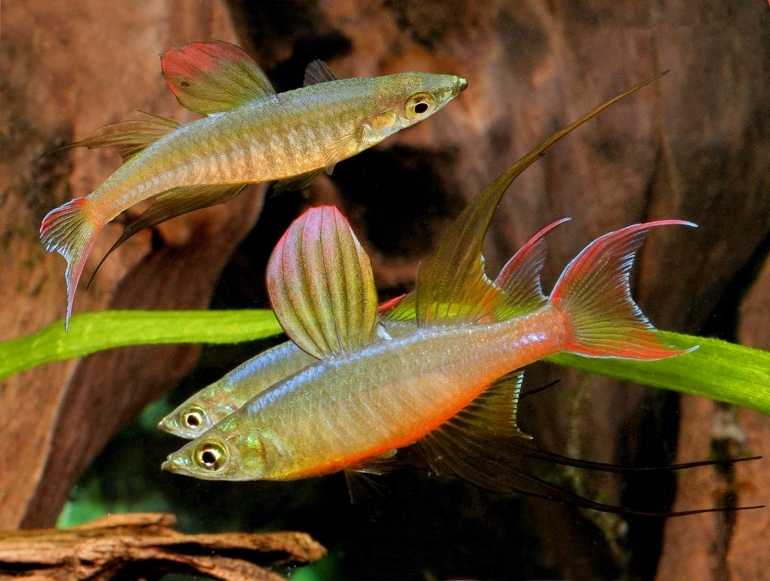 |
Iriatherina werneri photo© Hristo Hristov |
The number of rainbowfishes found in New Guinea seems to increase with each succeeding collection, producing new species and extending the range of species already known. Gerald Allen has added at least eighty new fish species to the scientific literature. This includes about forty species of rainbowfishes (including one new genus), nine species of blue-eyes, fourteen species of gudgeons, nine species of gobies, plus various species in other families. This only emphasises the fact that there is still much more exploration to be done. Not only in defining ranges of known species and in discovering new ones, but also in finding out something about their biology and ecology which, for many of the species, practically nothing is known. There remains an incredible number of yet undescribed or undiscovered rainbowfishes inhabiting the New Guinea wilderness. They are likely to remain undiscovered for many years due to the extremely rugged terrain, impenetrable jungle, and lack of basic infrastructure such as roads and airports. New Guinea is today less known than any other habitable area of equal size on the globe.
Increased understanding of rainbowfish systematics and distribution has largely stemmed from the application of collecting and systematic techniques by professional ichthyologists. However, no less significant has been the input from amateur ichthyologists and aquarists. In particularly, during the last three decades a profound increase in interest in keeping rainbowfishes has resulted in the formation of various specialty societies e.g., Australia New Guinea Fishes Association (ANGFA) and the Internationale Gesellschaft für Regenbogenfische (IRG), and in numerous amateur collecting expeditions. This, in combination with taxonomic and field studies, mainly by Gerald R. Allen, has resulted in a dramatic increase in the number of species recognised in this family; of the approximately 110 species and subspecies currently recognised, more than 80% have been described since 1978.
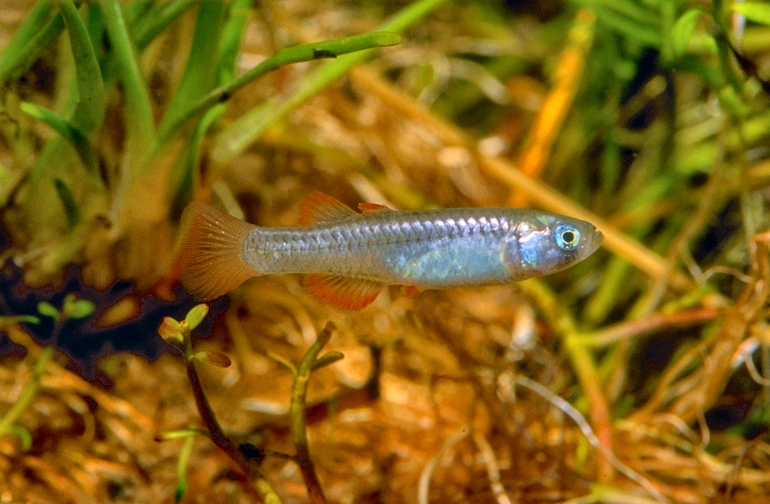 |
Scaturiginichthys vermeilipinnis photo© Gunther Schmida |
Other notable discoveries include Scaturiginichthys vermeilipinnis, a new genus and species of pseudomugilid from an artesian spring system in central Queensland (Ivantsoff et al., 1991); and numerous rainbowfish species endemic to various river and lake systems in New Guinea. There have also been significant advances in our understanding of the phylogenetic relationships and biogeography of melanotaeniid fishes in Australian and
New Guinea (Zhu et al. 1994; McGuigan et al. 2000; Unmack 2001).
The first rainbowfish (Melanotaenia nigrans) was scientifically described in 1843 from a collection of freshwater fishes acquired in the Northern Territory. They were collected by John Gilbert in 1840, from the King River, near Victoria Settlement in the Northern Territory, Australia. A single specimen ended up in the British Museum in London where John Richardson described it as a new species of hardyhead named Atherina nigrans. The differences between A. nigrans and the real hardyheads were enough for the American, Thomas Gill, to create the genus Melanotaenia for this lone species in 1862, still within the family Atherinidae. The next step was the creation of a subfamily Melanotaeniinae by Gill in 1894 to stress the differences with the hardyheads even more. However, another 70 years were to pass before Ian Munro treated the rainbowfishes as an independent family for the first time in 1964. Although a greater variety of Australian rainbowfishes were by then scientifically identified, many New Guinea rainbowfishes were still undiscovered. Gerald Allen, whilst employed with the Western Australian Museum, undertook a full generic classification of the rainbowfish family in 1980.
Rainbowfishes form the most speciose group of fishes inhabiting freshwaters within the Australia-New Guinea region. Despite this, relatively little is known about the biology and ecology of the majority of rainbowfish species in their natural habitat. A review of the literature currently available does highlight a number of gaps in our knowledge of many species. There are some species where there is a considerable amount of information available while there are other species where there is little or no information available. In addition, there are specific gaps in the information available in otherwise well documented species. As well as a number of species that are in need of additional research, information such as reproduction and natural habitat conditions is limited. These include water quality requirements, spawning frequency and habitat preferences. Spawning information in the wild is particularly lacking for almost all species, as is general information on egg and larvae development, habitat preference and water quality tolerances.
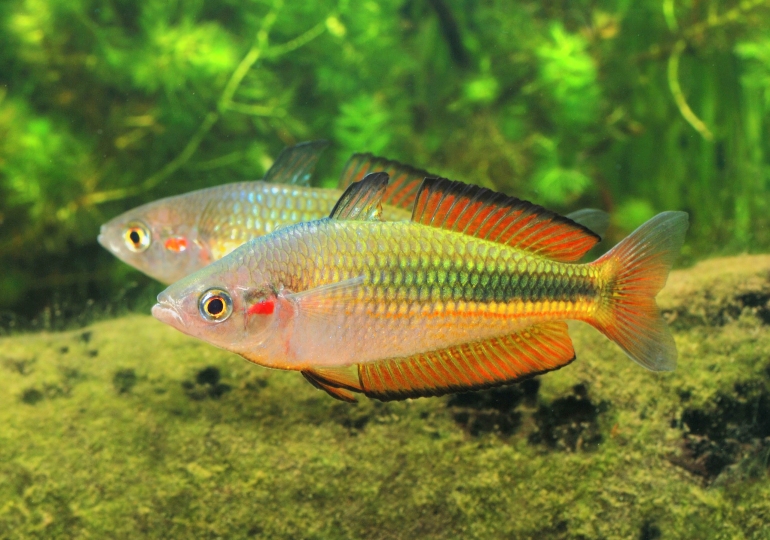 |
Melanotaenia duboulayi [Richmond River, NSW] photo© Gunther Schmida |
Despite such a variety of species, research into their basic natural biology and ecology is lacking and most information that is available is mainly based on aquarium observations. Obviously, there is urgent need for such studies in order that species can be properly conserved and managed. Clearly, there is also need for much more survey work to be done in Australia and New Guinea, as some areas remain poorly collected. There is also a need for more careful study of the many widespread species, as it is highly likely that such study will lead to a significant increase in the number of recognised species. For example, variation in morphology within the Melanotaenia genus is high, with species differing from one another though small variations in colour, morphology and meristics. Indeed, one species, Melanotaenia splendida, has been divided into many geographic forms, each with highly restricted, allopatric distributions. Populations of almost every river system they occupy have their own distinctive body colour and pattern. At the same time, body form within species is relatively pliant and appears to be dependent upon streamflow and correlated habitat characteristics, which can sometimes make identification in the field difficult. Much could be gained from careful analysis of the many morphological characters already at hand, such as the colouration characters noted for many of the rainbowfish "varieties". Colouration characters, however, when not supported by other characters, have generally been dismissed by ichthyologists working on rainbowfishes from Australia.
The recognition of taxonomic diversity is a key issue underlying the problems associated with assigning species status to this group of fishes. Rainbowfish are highly variable in form and recent efforts at distinguishing them have required genetic techniques to determine differences between them. Can we be sure that a species is truly defined, or is it a species complex, or multiple species with distinct characteristics - sufficiently isolated to be recognised as a species? Where a single species might be seen as common, in reality there might be numerous species. Distinct geographic clades within species are regarded alternatively as 'Evolutionarily Significant Units' (Moritz 1994) and are not named. An evolutionarily significant unit is a population of organisms that is considered distinct for purposes of conservation. This term can apply to any species, subspecies or geographic population. Subspecies are morphological variants distinguished at the level of the population - 75% or more of the individuals of the populations of one subspecies can be distinguished from those of other subspecies.
 GS.jpg) |
Rhadinocentrus ornatus [Evans Head, NSW] photo© Gunther Schmida |
These are also times of serious concern for the present and future health of rainbowfish populations, and other aquatic organisms. Existing data suggest that New Guinea is worthy of the highest conservation priority due to its extraordinary species diversity, significant endemism, and high degree of threat. New Guinea, particularly the Indonesian province of West Papua, is one of the most threatened biological hotspots, with its plants and animals facing possible extinction due to slash-and-burn subsistence farming, transmigration, rampant logging, illegal poaching, mining and other practices. Many human activities are increasingly disturbing and, in some cases, destroying freshwater habitats. Wherever human populations are expanding, so too are the harmful waste products of mining, industry, agriculture, and urban growth. These impacts have negative and sometimes devastating effects on aquatic habitats and life. Freshwater fish species and aquatic communities have also been placed in harm's way by the introductions of non-native species. The early settlement of Australia by Europeans was marked by a disregard of the value of native flora and fauna. Indiscriminate and unsustainable harvesting, massive habitat destruction, and the introduction of exotic plants, animals and diseases caused havoc amongst native populations. Introduced fish, such as European carp (Cyprinus carpio), mosquitofish (Gambusia holbrooki) and trout dominated ecosystems in many streams at the expense of native species.
Specific rainbowfishes that are considered threatened are: Chilatherina axelrodi, C. bleheri, C. bulolo, C. sentaniensis, Glossolepis incisus, G. maculosus, G. pseudoincisus, G, ramuensis, G. wanamensis, Kiunga ballochi, K. bleheri, Melanotaenia ajamaruensis, M. angfa, M. arfakensis, M. boesemani, M. catherinae, M. corona, M. eachamensis, M. exquisita, M. gracilis, M. herbertaxelrodi, M. iris, M. lacustris, M. maylandi, M. misoolensis, M. monticola, M. ogilbyi, M. oktediensis, M. papuae, M. parva, M. pimaensis, M. praecox, M. pygmaea, M. sexlineata, M. vanheurni, Pseudomugil connieae, P. furcatus, P. majusculus, P. mellis, P. paskai, and Scaturiginichthys vermeilipinnis (Conservation International 2002; IUCN 2009).
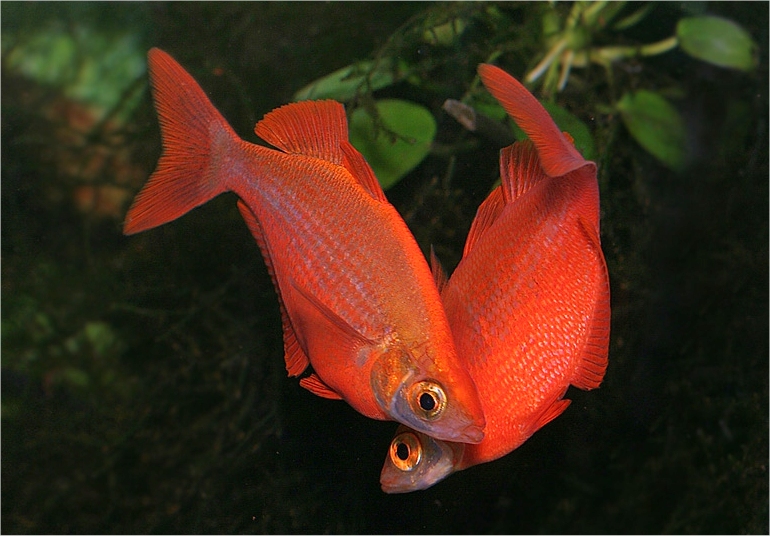 |
Glossolepis incisus photo© Hristo Hristov |
Literature
Allen G. R. (1980) A Generic Classification of the Rainbowfishes (Family Melanotaeniidae). Records of the Western Australian Museum 8 (3): 449-490.
Allen G.R. & N.J. Cross (1982) Rainbowfishes of Australia and New Guinea. TFH Publications Inc., New Jersey. USA.
Allen G.R. (1989) Freshwater Fishes of Australia. TFH Publications, Neptune City, New Jersey. USA.
Allen G.R., S.H. Midgley and M. Allen (2002) Freshwater Fishes of Australia. Western Australian Museum, Perth.
Allen G.R. (1991) Field Guide to the Freshwater Fishes of New Guinea. Christensen Research Institute (Madang, Papua New Guinea), Publication 9: 1-268.
IUCN (2009) IUCN Red List of Threatened Species. Version 2009.1. Downloaded on 04 September 2009.
Ivantsoff W., P. Unmack, B. Saeed and L.E.L.M. Crowley (1991) A red-finned blue-eye, a new species and genus of the family Pseudomugilidae from central-western Queensland. Fishes of Sahul 6(4): 277-282.
Lundberg J.G., M. Kottelat, G.R. Smith, M.L. J. Stiassny and A.C. Gill (2000) So Many Fishes, So Little Time: An Overview of Recent Ichthyological Discovery in Continental Waters. Annals of the Missouri Botanical Garden 87(1): 26-62.
McGuigan K., D. Zhu, G.R. Allen and C. Moritz (2000) Phylogenetic relationships and historical biogeography of melanotaeniid fishes in Australia and New Guinea. Marine and Freshwater Research 52: 713-23.
Moritz C. (1994) Defining "Evolutionarily Significant Units" for conservation. Trends in Ecology and Evolution 9 :373-375.
Report on Biodiversity and Tropical Forests in Indonesia (2004) Prepared for USAID/Indonesia Jl. Medan Merdeka Selatan No. 3-5 Jakarta 10110 Indonesia.
Saeed B., W. Ivantsoff and G. R. Allen (1989) Taxonomic revision of the family Pseudomugilidae (Order Atheriniformes). Australian Journal of Marine and Freshwater Research 40: 719-787.
Unmack P.J. (2001) Biogeography of Australian freshwater fishes. Journal of Biogeography, 28(9): 1053-1089.
Zhu D., B.G.M. Jamieson, A. Hugall and C. Moritz (1994) Sequence evolution and phylogenetic signal in control-region and cytochrome b sequences of rainbowfishes (Melanotaeniidae) in Molecular Biology and Evolution 11: 672-683.
Adrian R. Tappin
September, 2015



|
|

